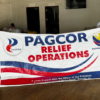Typhoon Usagi, referred to as Super Typhoon Ofel in the Philippines, emerged as a formidable natural disaster, wreaking havoc across Northern Luzon and Taiwan. The tropical cyclone formed on 9 November and dissipated on 16 November, gaining unprecedented strength with wind speeds reaching an alarming 150 mph. Classified as one of the most powerful storms to strike the region in recent years, its impact was felt deeply by local communities and governments alike.
Humanitarian Impact of Typhoon Ofel
Evacuations and Displacement
The destructive force of Typhoon Ofel prompted the evacuation of approximately 10,000 residents in vulnerable areas before the storm made landfall. Despite these proactive measures, the National Disaster Risk Reduction and Management Council (NDRRMC) reported that over 852,000 people were affected, with 112,000 individuals displaced. These staggering figures underline the severe challenges faced by communities in rebuilding their lives.
Relief Operations by PAGCOR
In response to the widespread devastation, the Philippine Amusement and Gaming Corporation (PAGCOR) mobilized a massive relief effort. PAGCOR prepared over 21,000 relief packs to be distributed to residents in the most affected areas, including Apayao, Cagayan, Isabela, Pagudpud, and Ilocos Norte. An additional 11,000 packs were allocated for delivery to heavily impacted municipalities in Cagayan, such as Aparri, Baggao, Ballesteros, Buguey, Calayan, Sanchez Mira, and Santa Teresita.
PAGCOR Chairman and CEO Alejandro Tengco emphasized the corporation’s commitment to aiding affected communities, stating: “We have been in close coordination with the Office of Civil Defense to facilitate the distribution of these relief aids to severely affected communities. We understand the need of these local communities to receive all the help they can get and enable them to rise above their dire situation.”
Economic Impact of Typhoon Ofel
Damage to Infrastructure
The typhoon inflicted severe damage on the Philippines’ infrastructure, with reported losses amounting to PHP469.8 million (US$9.54 million). Roads, bridges, and public facilities bore the brunt of the storm’s force, leaving many areas inaccessible and in urgent need of repair.
Agricultural Losses
The agricultural sector, a cornerstone of the Luzon economy, also suffered significantly. Typhoon Ofel caused damages worth PHP1 million to agricultural assets, contributing to a staggering PHP1.4 billion in total agricultural losses from typhoons over the past few weeks. Crops, livestock, and irrigation systems were heavily impacted, jeopardizing food security and the livelihoods of countless farmers.
Coordination and Local Government Response
Collaborative Efforts with Local Governments
PAGCOR’s relief initiatives were carried out in collaboration with local government units (LGUs) to ensure accurate assessment and delivery of aid. Tengco highlighted PAGCOR’s efforts to leave no community behind, stating: “We have been actively working with affected LGUs to determine the number of displaced families that needed help and to ensure that no community is left behind.”
Office of Civil Defense Support
The Office of Civil Defense (OCD) played a crucial role in facilitating relief operations, coordinating logistics to distribute aid effectively. The partnership between PAGCOR and the OCD underscored the importance of a unified approach in disaster response efforts.
The Long Road to Recovery
Immediate Needs
The immediate focus in the aftermath of Typhoon Ofel remains on providing shelter, food, and medical assistance to displaced individuals. Relief efforts must also address the psychological trauma experienced by survivors, ensuring they receive the support needed to rebuild their lives.
Infrastructure Rehabilitation
Reconstruction of damaged infrastructure is a critical priority to restore connectivity and support economic activities in affected areas. Governments and private organizations must work together to expedite the rebuilding process while incorporating measures to enhance resilience against future typhoons.
Agricultural Recovery
Revitalizing the agricultural sector is essential to mitigate long-term economic impacts. Efforts should include providing financial assistance to farmers, distributing seeds and equipment, and implementing climate-resilient farming practices.
A Call for Enhanced Disaster Preparedness
Typhoon Ofel serves as a stark reminder of the increasing frequency and intensity of natural disasters in the region, likely exacerbated by climate change. Strengthening disaster preparedness is imperative to mitigate the impact of future typhoons. This includes:
- Investing in resilient infrastructure to withstand extreme weather events.
- Enhancing early warning systems to provide timely information to communities.
- Promoting community-based disaster risk reduction programs to build local capacities.
Conclusion: The Response
Super Typhoon Ofel’s devastating impact highlights the critical need for coordinated relief efforts and robust disaster preparedness. The collaborative response by PAGCOR, the OCD, and local governments demonstrates the resilience and solidarity of the Filipino people in the face of adversity. However, the road to recovery will require sustained efforts and significant resources to restore livelihoods, rebuild infrastructure, and ensure communities are better equipped for future challenges.
FAQs About Typhoon Ofel’s Impact and Response
1. What is Typhoon Ofel, and when did it occur?
Typhoon Ofel, internationally known as Typhoon Usagi, was a super typhoon that struck Northern Luzon in the Philippines and Taiwan. It formed on 9 November and dissipated on 16 November, with wind speeds reaching 150 mph.
2. How many people were affected by Typhoon Ofel?
The typhoon impacted over 852,000 people, with 112,000 individuals displaced. Additionally, approximately 10,000 residents were evacuated as a precaution before the storm hit.
3. What areas were most affected by Typhoon Ofel?
The most affected areas include Northern Luzon, specifically Apayao, Cagayan, Isabela, Pagudpud, and Ilocos Norte, as well as various municipalities in Cagayan such as Aparri, Baggao, Ballesteros, Buguey, Calayan, Sanchez Mira, and Santa Teresita.
4. What relief efforts were initiated in response to the typhoon?
The Philippine Amusement and Gaming Corporation (PAGCOR) prepared over 21,000 relief packs for immediate distribution and allocated an additional 11,000 packs for the most severely affected municipalities in Cagayan. Relief operations were conducted in collaboration with local government units (LGUs) and the Office of Civil Defense (OCD).
5. How much damage did Typhoon Ofel cause to infrastructure?
The typhoon caused approximately PHP469.8 million (US$9.54 million) in infrastructure damages, affecting roads, bridges, and other essential facilities in Northern Luzon.
6. What was the economic impact on agriculture?
Typhoon Ofel caused PHP1 million in agricultural damages, contributing to a total of PHP1.4 billion in agricultural losses from typhoons in recent weeks. Crops, livestock, and irrigation systems were severely affected.
7. What measures are being taken to help affected communities recover?
Efforts include:
- Distributing relief packs to displaced families.
- Rebuilding infrastructure to restore connectivity.
- Providing financial and technical assistance to farmers for agricultural recovery.
- Ensuring psychological support for affected individuals.
8. How did PAGCOR coordinate its relief efforts?
PAGCOR worked closely with the Office of Civil Defense (OCD) and affected LGUs to assess the needs of displaced families, distribute relief packs, and ensure that no community was overlooked in the relief process.
9. What challenges are expected in the recovery process?
The recovery process will involve:
- Addressing the immediate needs of displaced families, such as shelter, food, and medical care.
- Accelerating infrastructure repairs to restore economic activity.
- Supporting the agricultural sector to rebuild livelihoods.


















